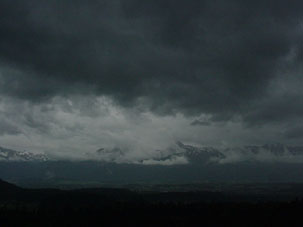

The amount of water vapour in the air varies. The percentage of water vapour in the air compared to what the air can hold at that certain temperature is called humidity. People often confuse the terms humid and heat when talking about what they are feeling. Heat, as discussed in the section on temperature, relates to the amount of solar energy contained in the air. Humidity relates to the amount of water vapour within the air and is recognised by the discomfort through stickiness.
Humidity is measured using instruments called hygrometers. The standard hygrometer measures the difference in temperature of the air and that of a thermometer attached to a wet wick known as a wet and dry bulb thermometer. As evaporation occurs, it represents a cooling process and hence the temperature on the thermometer containing the wick will give a lower reading of temperature. A conversion scale is used to convert the difference in temperature of both thermometers to the relative humidity reading at that dry air temperature. Other hygrometers have scales that indicate humidity directly. The humidity scale is measured on a scale 0 to 100 since it is a percentage. When humidity reaches 100%, condensation occurs. At 0%, the air would be extremely dry.

[ Images above ] Left: On rainy days the humidity is very high. The dark layer in the foreground is nimbostratus pannus.; Right: Another phenomenon that comes along with high humidity - mist. [ Location: Oberdiessbach, Switzerland ]
To compare the amount water vapour in the air, it is important to consider both the humidity and temperature. For instance, a day of about 27 degrees Celsius and 85% humidity has more water vapour than a day with a temperature of 27 degrees Celcius and 43% humidity. Air on a day that is warmer can hold more water vapour. Therefore, often the trend on a normal fine sunny day is to observe the relative humidity to drop during the day as the tempereature rises and increase as the temperature drops during the evening. On a wet day, the relative humidity is quite high and remains almost unchanged if the rain persists and there are no significant changes in the wind speed.
Examples of observations of humidity other than discomfort are fog, mist, cloud and rain that indicate environments of very high humidity. Over the long term, if the rate of evaporation decreases dramatically such as when drying clothes, the humidity is high. If the evaporation rate increases dramatically at a particular temperature, humidity has dropped significantly. Remember that humidity is defined according to the temperature and does not directly indicate how much water vapour is in the air.
Observing clouds | Observing cloud movement | Observing sunrises and sunsets | Observing clouds during sunrise and sunset | Observing fog, mist, frost and dew | Observing the temperature of the air | Observing wind
General Cloud Classification System | SYNOP Code | Picture
Gallery | Site Map | Weather Links
Copyright note | Contact | Miscellaneous | My
Astronomy Site on the Web